L4 autonomous driving research: the industry enters a new development phase, "dimension reduction + cost reduction".
L3/L4 autonomous driving enjoys much greater policy support.
The development of L3/L4 autonomous driving needs both policy and technology support. Since 2022, China has given far greater policy support to high-level autonomous driving.
The Development Plan for New Energy Vehicle Industry (2021-2035) issued by the State Council indicates that "by 2025, L4 vehicles will be commercialized in limited areas and specific scenarios, and by 2035, L4 vehicles will find massive application."
On March 1, 2022, the national recommended standard GB/T 40429-2021 Taxonomy of Driving Automation for Vehicles came into force. In November 2022, the Ministry of Industry and Information Technology together with the Ministry of Public Security organized the drafting of Notice on Piloting Entry and Road Travel of Intelligent Connected Vehicles (Draft for Comments), suggesting piloting the entry of production-ready intelligent connected vehicles with autonomous driving functions (L3 and L4 in the GB/T 40429-2021 standard).
As concerns local governments, the Administrative Rules of Beijing Municipality for Autonomous Shuttles in the Pilot Areas Carrying out Intelligent Connected Vehicle Policies (Road Test and Demonstration Application) released in November 2022, is China’s first policy to give the corresponding right of way in the form of coding to autonomous shuttles. In August 2022, the Regulation on the Administration of Intelligent Connected Vehicles in Shenzhen Special Economic Zone came into effect. It is China’s first L3 autonomous driving regulation that highlights the first clear identification of accident responsibilities.
As the knockout starts, L4 autonomous driving suppliers seek "cost reduction + dimension reduction", and the industry enters the phase of large-scale commercial application.
At present, the installation rate of autonomous driving functions in vehicles is on the rise, and L2/L2+ autonomous driving technology has been relatively mature. The competition in the market is white hot. To gain more competitive edges, OEMs and autonomous driving solution providers compete to enter the track of higher-level autonomous driving.
Yet high-level autonomous driving consumes more capital, and is unlikely to build a full commercial closed-loop in the short term. In October 2022, Argo AI, a star start-up specializing in L4 autonomous driving, declared bankruptcy due to the capital chain rupture, a result of the inability to attract further investments, as its backers Ford and Volkswagen decided to stop investing in it.
Despite ceasing to invest in Argo AI and turning the focus on L2+/L3 that is easier to implement, Ford is still optimistic about L4 autonomous driving, but chooses not to develop on its own. It would team up with L4 autonomous driving solution providers in the future.
The case of Argo AI shows the challenges faced by L4 autonomous driving suppliers in current stage. If they do not try to develop real commercial solutions, they may eventually be weeded out by the market under capital pressure. To run farther on L4 autonomous driving track, all major suppliers aim at the mass production OEM market of passenger cars and embark on “dimension reduction” application, while working hard on L4 technology.
(1) “Dimension reduction” application
QCraft: propose the dual engine strategy. On one hand, based on public road L4 autonomous driving software and hardware solutions, it makes continuous efforts to improve its technical competence; on the other hand, based on the mass production and large-scale application of autonomous driving for OEM market, it keeps expanding application scenarios.
In May 2022, QCraft introduced DBQ V4, an autonomous driving solution for passenger car OEM market. Supporting 1 to 5 LiDARs, 0 to 4 blind spot radars, 6 radars and 12 perception cameras, it enables 360-degree perception without missing blind spots and dead corners, and allows mutual redundancy between left and right. It also packs a customized traffic light recognition camera. The solution is expected to be mass produced and mounted on vehicles during 2023-2024.
DBQ V4 offers standard and high configuration versions. The high configuration version has all L4 autonomous driving functions. Compared with high configuration version, the standard version features a slightly lower configuration, but it can still enable 99% L4 autonomous driving capabilities. The DBQ V4 autonomous driving solution integrates full-stack autonomous driving software and hardware technologies independently developed by QCraft. The standard version with a reduced LiDAR configuration carries a computing platform with lower computing power, cutting down the mass production cost to about RMB10,000. The mass-produced solution for the OEM market also enables driving and parking integrated functions.
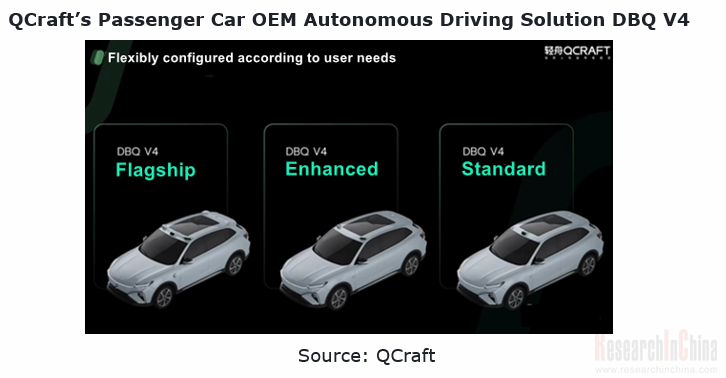
Cruise: since 2021, it has worked to build Ultra Cruise intelligent driving system for GM. This solution is mainly mounted on the high-end vehicle models of GM and complements the Super Cruise system, helping GM to apply driving assistance technologies to all of its models.
Compared with Super Cruise, Ultra Cruise has added some new autonomous driving functions:
?Follow the internal navigation route and keep moving forward;
?Observe the speed limit
?Support automatic and on-demand lane change
?Support automatic left and right turns
?Support close object avoidance
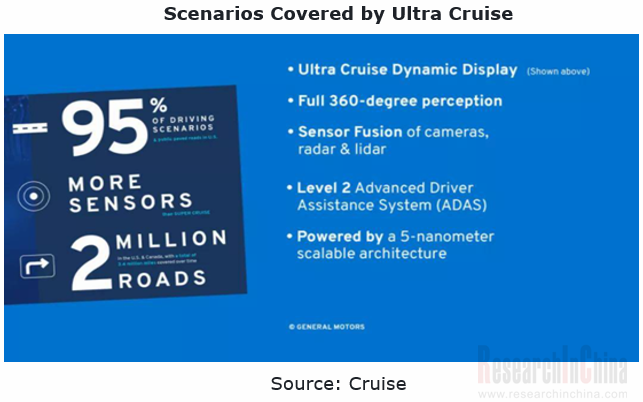
“Cost reduction” application
In addition, the high cost is also a major obstacle to the implementation of L4 autonomous driving products. In particular, for cost-sensitive passenger cars, it is obvious that L4 autonomous driving that generally costs hundreds of thousands of yuan doesn’t justify it. All suppliers therefore have begun to vigorously "cut down cost".
Deeproute.ai: in June 2022, Deeproute.ai launched DeepRoute-Driver 2.0, a low-cost L4 autonomous driving system worth USD10,000 (about RMB64,000). This solution carries 2 to 5 solid-state LiDARs and 8 cameras, Nvidia Orin high computing power automotive chip, integrated navigation and HD map, enabling high-level autonomous driving.
Deeproute.ai says that in the future the cost of L4 autonomous driving could be lowered to less than RMB20,000 by cooperating with conventional OEMs for mass production and purchasing hardware equipment uniformly.
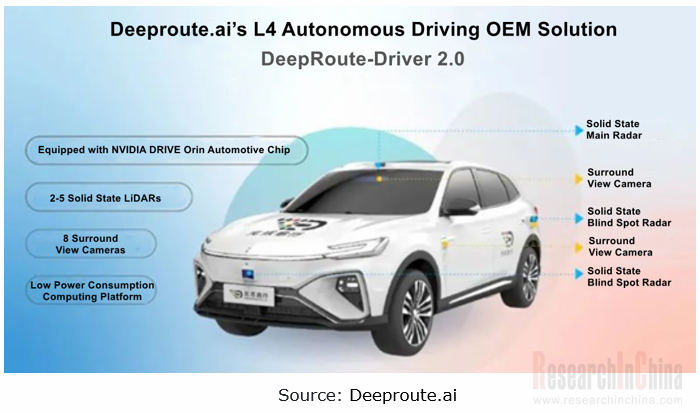
Haomo.ai: in April 2022, Haomo.ai launched Little Magic Camel 2.0, a product priced RMB128,800 for a single vehicle. Haomo.ai can build RMB100,000 autonomous distribution vehicles, mainly because its autonomous distribution vehicles reuse its passenger car autonomous driving technologies, and cost less by virtue of passenger car supply chain advantages. In terms of hardware, Little Magic Camel 2.0 that bears an automotive perception kit and ICU 3.0, a computing platform with high computing power can cover all medium- and low-speed road scenarios and all road conditions on urban public roads.
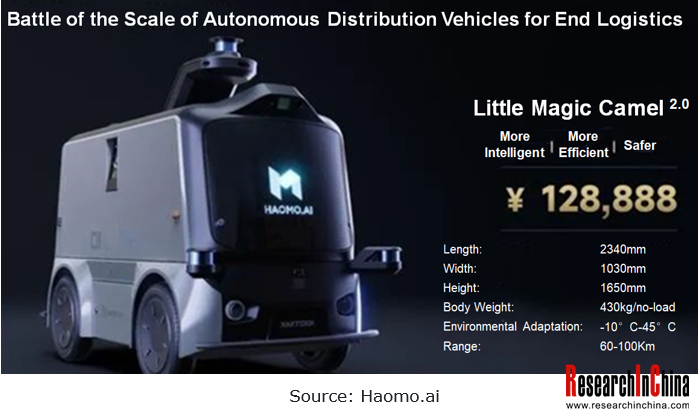
Technology reuse helps to expand multiple application scenarios for L4 autonomous driving systems.
Affected by technology maturity and regulatory restrictions, L4 autonomous driving is available to relatively limited application scenarios in the short run. The main application scenarios include Robotaxi, autonomous delivery, autonomous shuttle, and autonomous logistics in (semi) closed scenarios.
For L4 autonomous driving is being piloted in application fields, the deployment scale is not large, and just with tweaks, L4 autonomous driving technology can be reused in different types of vehicles, so L4 suppliers rarely follow a single business line, and generally make multi-scenario deployments.
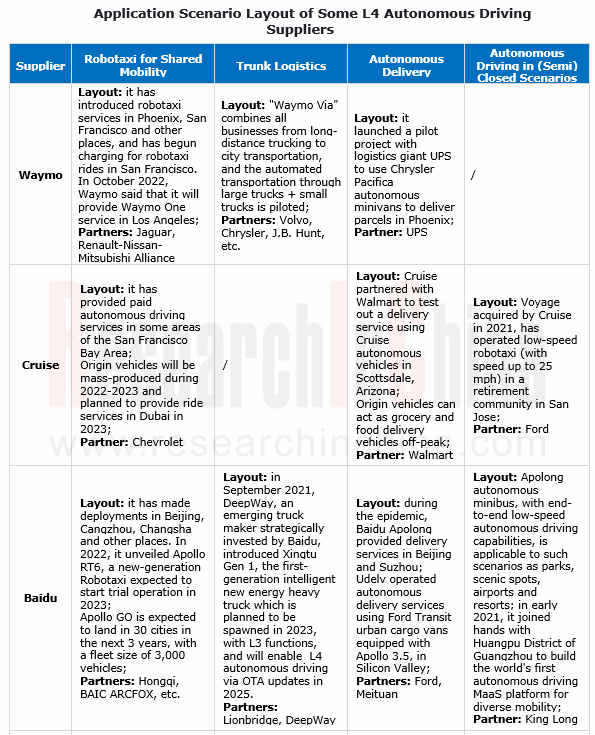
Global and China L4 Autonomous Driving and Start-ups Report, 2022 highlights the following:
 L4 autonomous driving (policies, standards, regulations, etc.);
L4 autonomous driving (policies, standards, regulations, etc.);
 L4 autonomous driving market (size, competitive landscape, etc.);
L4 autonomous driving market (size, competitive landscape, etc.);
 Key technologies (algorithm, HD map and positioning, data closed-loop, vehicle-road-cloud cooperation, redundancy, etc.) of L4 autonomous driving (major suppliers, technical solutions, etc.);
Key technologies (algorithm, HD map and positioning, data closed-loop, vehicle-road-cloud cooperation, redundancy, etc.) of L4 autonomous driving (major suppliers, technical solutions, etc.);
 Application scenarios (Robotaxi, autonomous shuttle, autonomous delivery, autonomous truck, etc.) of L4 autonomous driving (major suppliers, technical solutions, operation, etc.);
Application scenarios (Robotaxi, autonomous shuttle, autonomous delivery, autonomous truck, etc.) of L4 autonomous driving (major suppliers, technical solutions, operation, etc.);
 OEMs’ layout and planning of L4 autonomous driving solutions;
OEMs’ layout and planning of L4 autonomous driving solutions;
 Major L4 technology suppliers (technical solution iterations, application and layout of L4 products, etc.).
Major L4 technology suppliers (technical solution iterations, application and layout of L4 products, etc.).
Passenger Car Mobile Phone Wireless Charging Research Report, 2025
Automotive Wireless Charging Research: Domestic Installation Rate Will Exceed 50%, and Overseas Demand Emerges as Second Growth Driver.
The Passenger Car Mobile Phone Wireless Charging Research Repor...
Automotive 4D Radar Industry Research Report 2025
4D radar research: From "optional" to "essential," 4D radar's share will exceed 50% by 2030.
1. 4D imaging radar has transformed from an "optional" to a "must-have" sensor.
4D radar adds the detecti...
China Automotive Multimodal Interaction Development Research Report, 2025
Research on Automotive Multimodal Interaction: The Interaction Evolution of L1~L4 Cockpits
ResearchInChina has released the "China Automotive Multimodal Interaction Development Research Report, 2025"...
Automotive Vision Industry Report, 2025
Automotive Vision Research: Average Camera Installation per Vehicle Reaches 5.2 Units, and Front-View Tricam Installation Exceeds 1.2 Million Sets.
From January to September 2025, the total installa...
Automotive Infrared Night Vision System Research Report, 2025
Automotive night vision research: The rise of infrared AEB, with automotive infrared night vision experiencing a 384.7% year-on-year increase from January to September.
From January to September 2025...
New Energy Vehicle Cross-Domain (Electric Drive System and Powertrain Domain) Integration Trend Report 2025-2026
Electric Drive and Powertrain Domain Research: New technologies such as three-motor four-wheel drive, drive-brake integration, and corner modules are being rapidly installed in vehicles.
Electric dri...
Analysis on Desay SV and Joyson Electronic's Electrification, Connectivity, Intelligence and Sharing, 2025
Research on Desay SV and Joyson Electronic: Who is the No.1 Intelligent Supplier?
Both Desay SV and Joyson Electronic are leading domestic suppliers in automotive intelligence. "Analysis on Desay SV ...
OEMs and Tier 1 Suppliers' Cost Reduction and Efficiency Enhancement Strategy Analysis Report, 2025
ResearchInChina released the "OEMs and Tier 1 Suppliers' Cost Reduction and Efficiency Enhancement Strategy Analysis Report, 2025", summarizing hundreds of cost reduction strategies to provide referen...
Automotive Fixed Panoramic Sunroof and Smart Roof Research Report, 2025
With the intelligent application of car roofs as the core, this report systematically sorts out a series of new products such as fixed panoramic sunroof/openable sunroof, ceiling screen, roof ambient ...
Automotive-Grade Power Semiconductor and Module (SiC, GaN) Industry Research Report, 2025
SiC/GaN Research: Sales volume of 800V+ architecture-based vehicles will increase more than 10 times, and hybrid carbon (SiC+IGBT) power modules are rapidly being deployed in vehicles.
Sales volume o...
Cockpit Agent Engineering Research Report, 2025
Cockpit Agent Engineering Research: Breakthrough from Digital AI to Physical AI
Cockpit Agent Engineering Research Report, 2025 starts with the status quo of cockpit agents, summarizes the technical ...
Prospective Study on L3 Intelligent Driving Technology of OEMs and Tier 1 Suppliers, 2025
L3 Research: The Window of Opportunity Has Arrived - Eight Trends in L3 Layout of OEMs and Tier 1 Suppliers
Through in-depth research on 15 OEMs (including 8 Chinese and 7 foreign OEMs) and 9 Tier 1 ...
China Commercial Vehicle IoV and Intelligent Cockpit Industry Research Report 2025
Commercial Vehicle IoV and Cockpit Research: The Third Wave of Passenger Car/Commercial Vehicle Technology Integration Arrives, and T-Box Integrates e-Call and 15.6-inch for Vehicles
I. The third wav...
Intelligent Vehicle Electronic and Electrical Architecture (EEA) and Technology Supply Chain Construction Strategy Research Report, 2025
E/E Architecture Research: 24 OEMs Deploy Innovative Products from Platform Architectures to Technical Selling Points
According to statistics from ResearchInChina, 802,000 passenger cars with domain...
Research Report on Intelligent Vehicle Cross-Domain Integration Strategies and Innovative Function Scenarios, 2025
Cross-Domain Integration Strategy Research: Automakers' Competition Extends to Cross-Domain Innovative Function Scenarios such as Cockpit-Driving, Powertrain, and Chassis
Cross-domain integration of ...
China Autonomous Driving Data Closed Loop Research Report, 2025
Data Closed-Loop Research: Synthetic Data Accounts for Over 50%, Full-process Automated Toolchain Gradually Implemented
Key Points:From 2023 to 2025, the proportion of synthetic data increased from 2...
Automotive Glass and Smart Glass Research Report, 2025
Automotive Glass Report: Dimmable Glass Offers Active Mode, Penetration Rate Expected to Reach 10% by 2030
ResearchInChina releases the Automotive Glass and Smart Glass Research Report, 2025. This r...
Passenger Car Brake-by-Wire (BBW) Research Report, 2025
Brake-by-Wire: EHB to Be Installed in 12 Million Vehicles in 2025
1. EHB Have Been Installed in over 10 Million Vehicles, A Figure to Hit 12 Million in 2025.
In 2024, the brake-by-wire, Electro-Hydr...